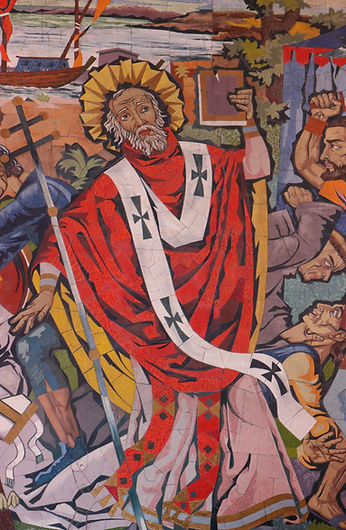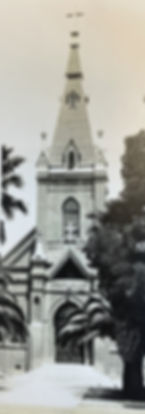
Our Patron, St. Boniface
Born in Devon, England in 675, St. Boniface was baptized Wynfrith, which means "friend of peace," since he is the child of a Saxon father and British mother. Wynfrith was educated in the monastery; and after years of school and formation, was ordained into Benedictine Order.
In May 719, Pope Gregory II gave Wynfrith the new name Boniface and appointed him the mission of evangelizing Bavaria and Hesse. In 722, Pope Gregory II consecrated Boniface of the Episcopacy.
On his return to Germany as Bishop, Boniface found that the challenge of paganism had worsened. People did no give up their old religion out of the fear of punishment by pagan deities. Knowing this, Boniface called the tribes to gather. As the people watched, he approached the giant Geismar tree dedicated to the god of thunder. With an axe, Boniface split the tree in four parts, which then fell to form a cross. Unharmed, Boniface showed the tribes that they had no reason to fear false gods; and so began Germany's Catholic conversion. In 732, Pope Gregory III gave Boniface the Pallium, making him Archbishop of all of Germany.

Parish History
Our story at Saint Boniface Catholic Church begins with the faith of the families who came before us, such as the Yorbas and the Rimpaus. These families opened their homes to priests traveling from nearby missions so Mass could be celebrated for the growing community. As the Catholic population expanded, the need for a permanent place of worship became urgent. With determination and unity, the faithful built the first modest wooden church in Anaheim in 1869, marking the formal beginning of what would become Saint Boniface Parish. By 1875, the parish was officially recognized, named after Saint Boniface, the apostle of Germany, reflecting the heritage of many early parishioners.
Through the late 19th century, Saint Boniface flourished as a center for worship, education, and community life. The parish welcomed the Dominican Sisters to Anaheim in 1888, who established St. Catherine’s School, providing Catholic education for local children. The parish grew alongside the city itself, eventually outgrowing its original wooden structure. This growth inspired the construction of a new, larger church in 1903, a Gothic-style building adorned with stained-glass windows, which became a proud symbol of faith and perseverance for the Catholic community of Anaheim.
As the decades passed, Saint Boniface continued to evolve, supporting parishioners through world wars, economic challenges, and waves of new families arriving in Anaheim. By the mid-20th century, the community’s devotion and numbers once again demanded a new spiritual home. Under the leadership of Father John Quatannens, the parish embarked on the construction of a new church, completed and dedicated in 1964. Designed in the style of its time, the church was built on Harbor and Lincoln and stands out with its marble, terrazzo flooring, and striking stained-glass windows. A prominent crucifix, mosaics of the Stations of the Cross, and a monumental statue of Saint Boniface emphasize the parish’s devotion and resilience.
Today, we continue to be a vibrant parish, welcoming people of all backgrounds to share in the Eucharist, in prayer, and in service. For more than 150 years, Saint Boniface has been a place where families come together to grow in faith and community. If you would like to learn more about our history, we invite you to stop by the Pastoral Center and receive a copy of One Bread One Body: 150 Years of Family, Community, and Service, Saint Boniface Catholic Church 1860–2010.

Was granted land on July 10 1810, by the Spanish Governor Arellaga. He names his land Rancho Santiago de Santa Ana — now known at the cities of Orange, Villa Park, Santa Ana, Tustin and Costa Mesa.

Was granted land on July 10 1810, by the Spanish Governor Arellaga. He names his land Rancho Santiago de Santa Ana — now known at the cities of Orange, Villa Park, Santa Ana, Tustin and Costa Mesa.

German immigrant who played a vital role in the establishment of a Catholic Community in Anaheim.

German immigrant who played a vital role in the establishment of a Catholic Community in Anaheim.

Was built on June 26, 1869. It was a simple building made of wood paneling. Rising only 16 feet an measuring 42 feet by 20 feet.

Was built on June 26, 1869. It was a simple building made of wood paneling. Rising only 16 feet an measuring 42 feet by 20 feet.

For many years, Holy Mass was celebrated in the front parlor of Rimpau's home when priests from the San Gabriel Mission came to serve the community's spiritual needs. In 1867, the Reverend Peter Verdagauer celebrated the first Mass in Anaheim.

For many years, Holy Mass was celebrated in the front parlor of Rimpau's home when priests from the San Gabriel Mission came to serve the community's spiritual needs. In 1867, the Reverend Peter Verdagauer celebrated the first Mass in Anaheim.

On March 19, 1889, just eight days after Orange County was incorporated, St. Catherine's school was dedicated in Anaheim.

On March 19, 1889, just eight days after Orange County was incorporated, St. Catherine's school was dedicated in Anaheim.

Under the pastoral care of the Reverend Francis Dubbel, a new St. Boniface was built in place of the old wooden building. Inspired by gothic architecture and adorned with elaborate stained glass windows, the new church took only one year to build, and offered five times the space that the old wooden building offered.

Under the pastoral care of the Reverend Francis Dubbel, a new St. Boniface was built in place of the old wooden building. Inspired by gothic architecture and adorned with elaborate stained glass windows, the new church took only one year to build, and offered five times the space that the old wooden building offered.

After being advised by several experts that mere structural improvements will not be sufficient, under the pastoral leadership of the Reverend John Quatannens, the people of St. Boniface broke ground on a new church building to accommodate their growing community. A stark contrast to it's predecessor, the new church takes on an architecture that is indicative of the mid century era in which it was designed.

After being advised by several experts that mere structural improvements will not be sufficient, under the pastoral leadership of the Reverend John Quatannens, the people of St. Boniface broke ground on a new church building to accommodate their growing community. A stark contrast to it's predecessor, the new church takes on an architecture that is indicative of the mid century era in which it was designed.

The new building would be located to the west of the corner of Harbor Boulevard and Lincoln Avenue.

The new building would be located to the west of the corner of Harbor Boulevard and Lincoln Avenue.


150 Years Anniversary 2025



















